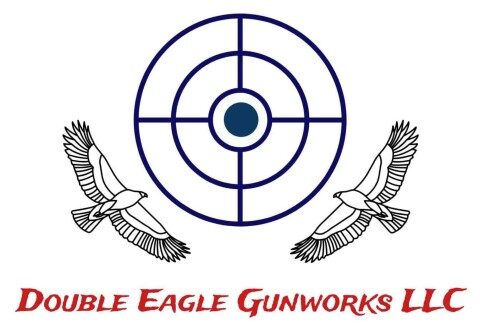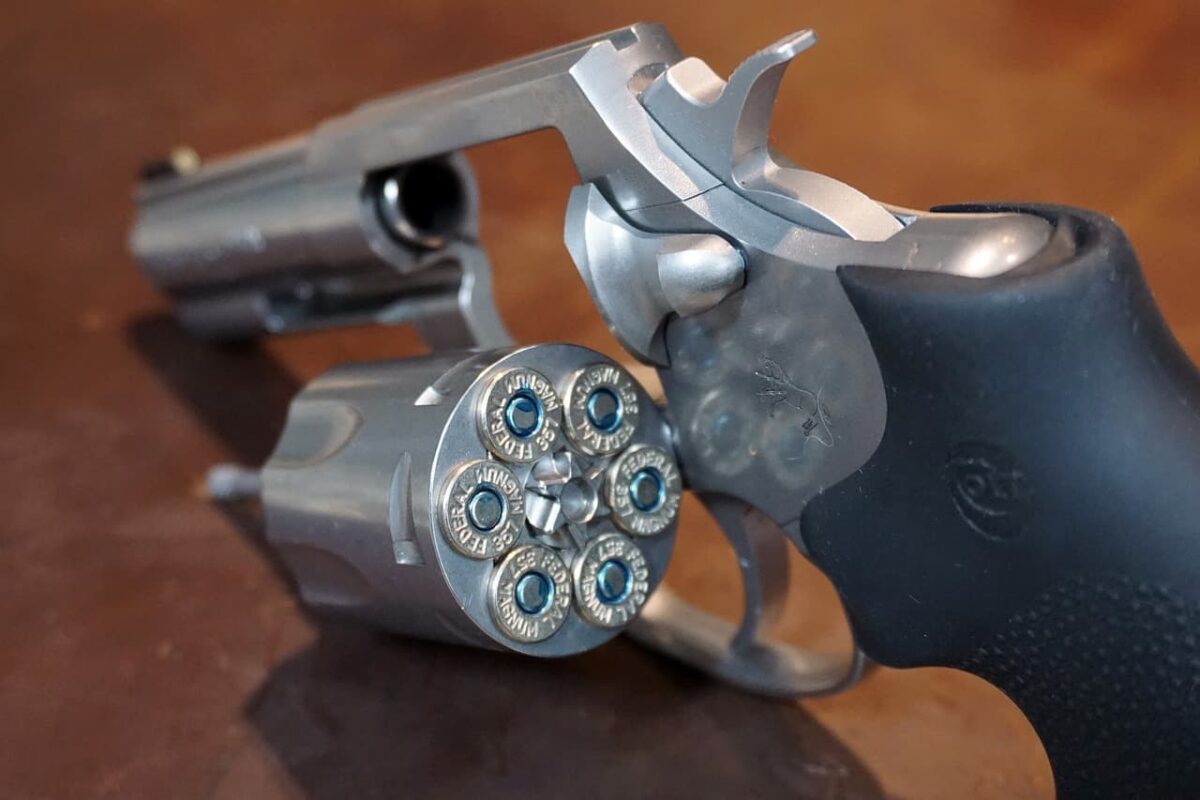Having explored the semi-automatic pistol, we turn now to its simpler and more elegant older sibling, the revolver.
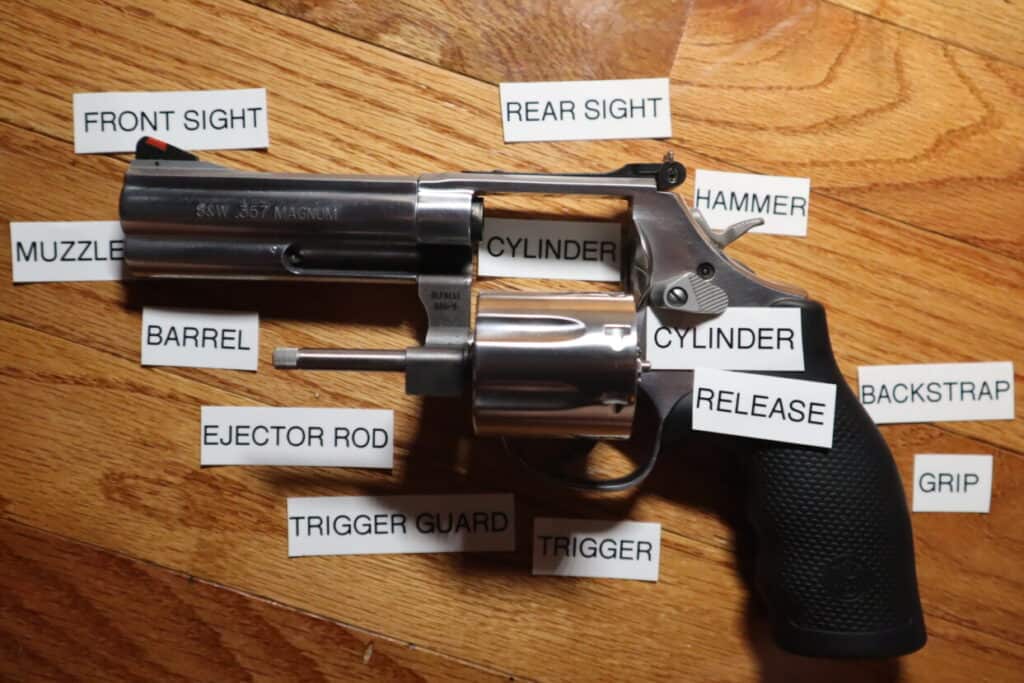
The semi-automatic dates from 1898, but the revolver has been around since the sixteenth century.
According to the American Society of Arms Collectors, in 1597 Xun Lei Chong invented a five-barreled musket revolver spear in China. It was equipped with “a cylinder containing several charges which revolves behind a barrel.”
The more familiar model that started America’s love affair with the revolver was invented by Samuel Colt, patented in Britain in 1835 and in America in 1836.
The revolver’s rounded contours please the eye and fit in the hand, and its simple operation puts self defense within reach of those who do not care to operate the more complex semi-automatic pistol.
The labeled photo above features a Smith and Wesson .357 Magnum. Modeling for us today is the Ruger LCR, my personal everyday carry gun.
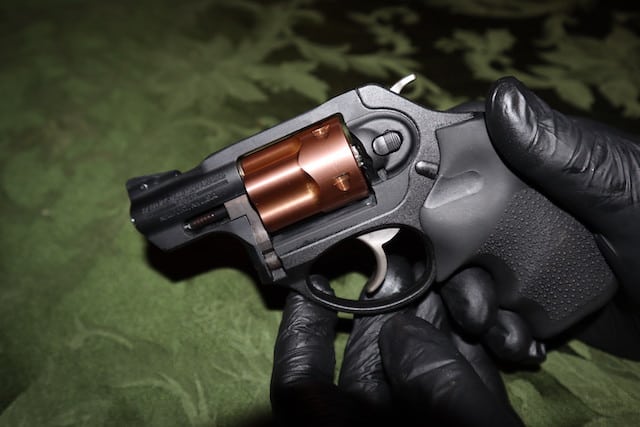
The Grip
The grip is the part that you hold in your hand. You can customize the grip’s shape and width to suit your hand. Grips can be smooth or textured, and may have indentations that help you position each finger.
The Backstrap
The Backstrap is the back surface of the grip.
The Muzzle
The very front of the gun, where the bullet comes out, is the muzzle. As with a dog, this is the part that bites, so always be aware of where your muzzle is pointing. Don’t point the muzzle at anything you aren’t willing to destroy— including your feet.
The Barrel
The muzzle is the front opening of the barrel. When you rotate the cyclinder and then pull the trigger, the bullet is forced out of the round and through the barrel to exit toward your target.
The Front and Rear Sights
Atop the muzzle is the front sight, with a long trough leading back to the rear sight. You look down the top of the gun and match the front sight to the rear sight to know where you will be sending your bullet.
The Frame
The frame is the body of the revolver. It holds everything else together.
The Cylinder
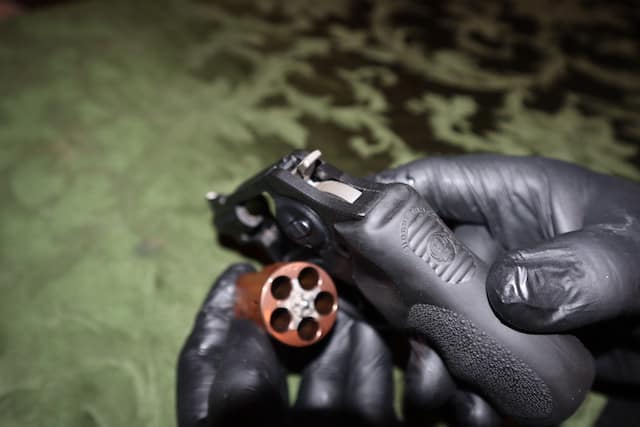
The cylinder, also called the wheel, is the barrel shaped part where you put the rounds. Each round has its own chamber. Shown here extended away from the frame, the cylinder rotates in a complete circle.
After you shoot, the case for each round will remain in the chamber.
The Crane

The crane, seen above, attaches the cylinder to the frame of the revolver and pivots to move it in or out of the frame.
The Ejector Rod
The ejector rod, extending out the front of the cylinder, can be pushed back to empty the spent cartridges after shooting. In the picture above we see the ejector rod from the front.
Go up one more picture and see the star shape in the middle of the cylinder. This is called the star, or ratchet. It holds the rounds in place until you move it by pressing the ejector rod.
After you shoot, you remove the spent casings by tilting the muzzle of the gun upward and pressing the ejector rod. This moves the star forward, allowing the casings to fall out of the chambers.
Cylinder Release
Just behind the copper-colored cylinder is the cylinder release. On the Ruger LCR you push it with your right thumb while using the index finger or the fingers of your left hand to push the cylinder out of the frame.
The cylinder release keeps the cylinder clicked into place while shooting and then allows you to swing the cylinder out when you are ready to reload. Depending on the model of the gun, you press, push, or pull to activate it.
Some revolvers have a release on the other side of the gun for ambidextrous use. As a lefty, I find it necessary to do this task the way a right-handed person would, because my left forefinger just cannot achieve that angle.
That does not pose a problem for me because I shoot both left- and right-handed. (As an aside, doing tasks with your opposite hand is a good way to build extra neuronal pathways that will help you adapt more quickly if you have a stroke or injury that affects your dominant side. That really came in handy when I broke my left collarbone).
The Hammer
At the top back end of the gun is the hammer. On a double action only gun this may be hidden inside the mechanism, because squeezing the trigger will move the hammer for you. Removing the external hammer gives a cleaner line that won’t snag on clothing.
On a single action revolver you will have to cock the hammer by pulling it back before each shot. My Ruger works both ways. You can cock the hammer for an easier trigger pull, or just squeeze the trigger when you want to shoot.
The hammer hits the firing pin, which activates the primer, causing the explosion of the powder charge in the cartridge, which shoots the gun. The primer is like the fuse on a firecracker.
The Trigger
The trigger is the comma-shaped appendage below the cylinder. When you squeeze the trigger you activate the action that shoots the gun.
The Trigger Guard
The trigger is surrounded by the trigger guard, which serves as a barrier to accidental discharge. Keep your finger away from the trigger until you are ready to shoot.
The Firing Pin
At the back of the picture of the crane, behind where the cylinder sits in the frame, is the firing pin. When you squeeze the trigger, the firing pin strikes the cartridge to detonate the powder that explodes in order to send the bullet on its way to your target.
The Ammunition
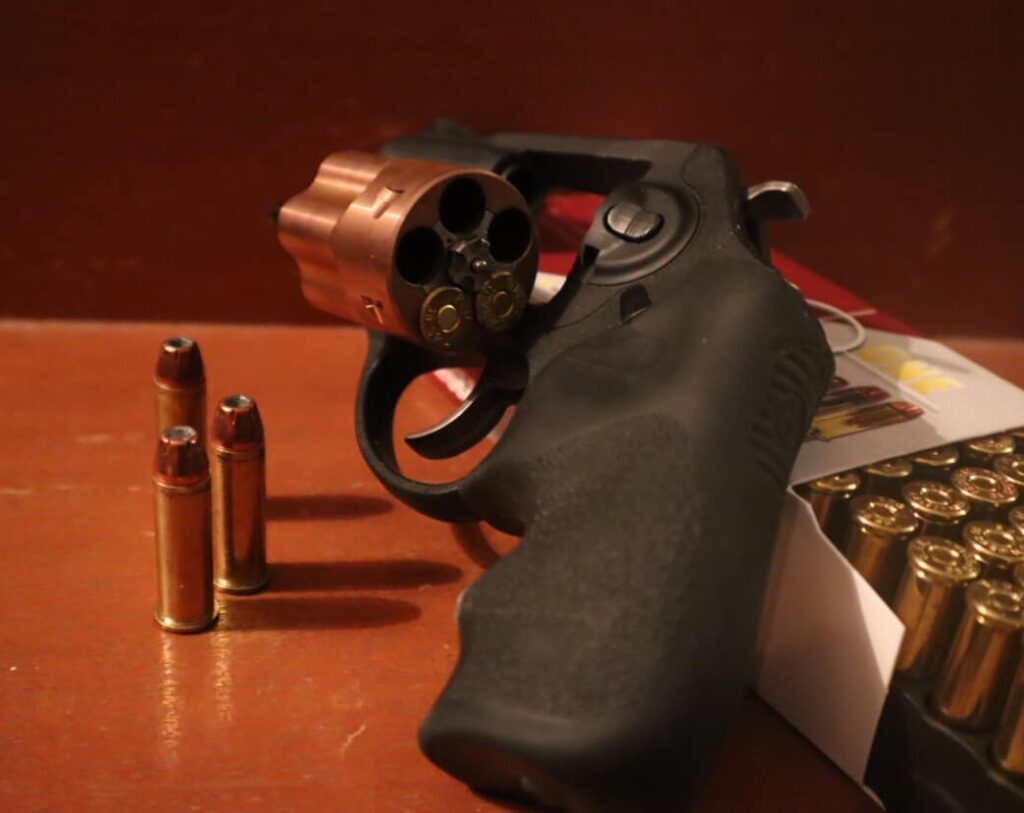
Revolvers use cartridges consisting of the case, the primer, the powder, and the bullet. Each cartridge has a rim that will catch on the edge of the chamber rather than going all the way through when you load it.
The star holds the rim in place and retains the case when you shoot the bullet out through the barrel.
Putting It All Together
Now that we know the names of the parts and what they look like, let’s go through what happens when you shoot a revolver.
- You use the cylinder release to open the cylinder and swing it out
- You load each round into a chamber of the cylinder
- You close the cylinder and snap it into alignment with the barrel
- For a single action revolver, you pull back the hammer
- The cylinder rotates to a fresh round as the hammer is cocked
- A double action activates the hammer with the trigger pull
- You squeeze the trigger
- The trigger moves the hammer to hit the firing pin
- The firing pin strikes the primer in the bottom of the round
- The primer activates the powder, which causes an explosion
- The gases released in the explosion propel the bullet out of the barrel
- The case is retained in the chamber
- You are ready for your next shot
